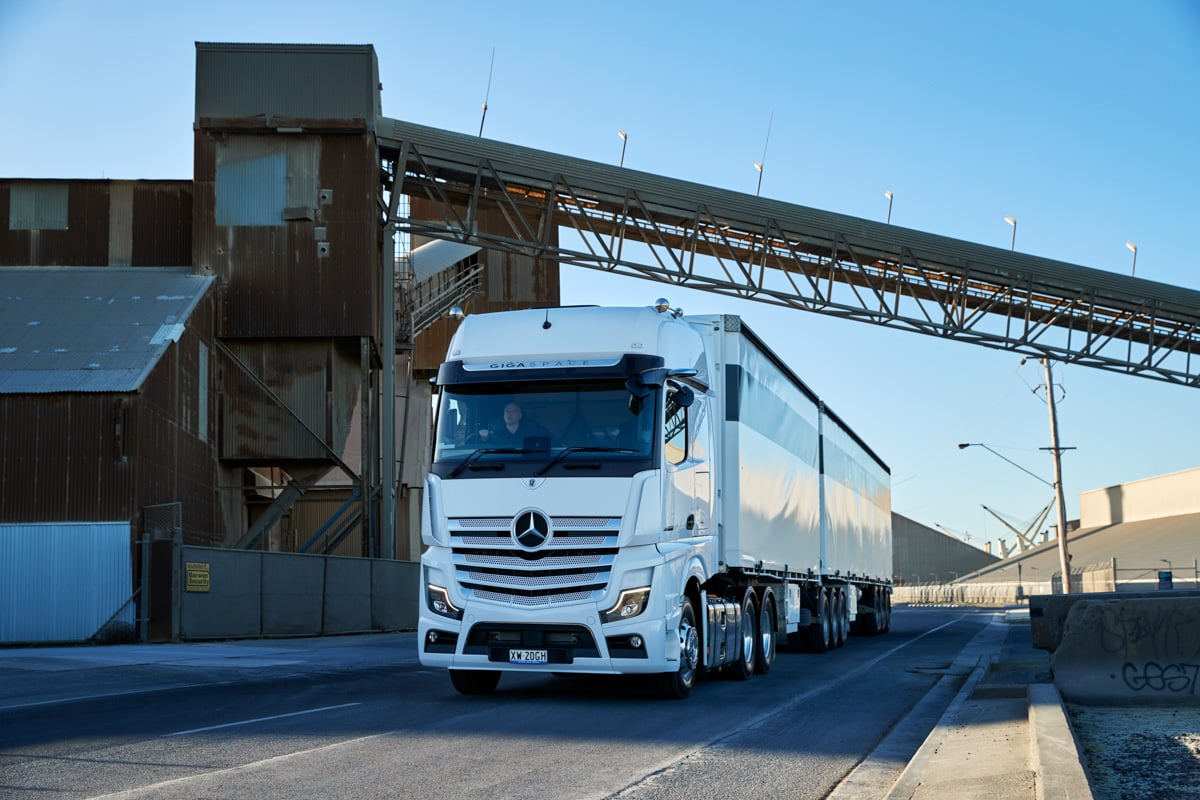
20 years is a long time in the world of trucks and trucking, it is also the time between Tim Giles’ very first drive of a Mercedes-Benz Actros with a MegaSpace cab and his most recent experience with the latest version of the Mercedes-Benz Actros GigaSpace truck, on the road from Melbourne to Adelaide.
One takeaway, when comparing that truck of 20 years ago and this second experience is a major component which has transformed the truck offering from the whole Daimler organisation, globally, and that is the Power Shift AMT.
In this particular case it’s the 12 speed power shift running through a 1:3.583 rear axle ratio which gives us 1436rpm at 100 km/h out on the highway.
Where the transmission in that 2003 truck was plodding and not very reactive, this latest iteration of the AMT in the Mercedes-Benz is smooth, reactive, easy to use and reliable. The development of AMTs, as a whole, in the intervening 20 years between these two test drives has seen transmissions become much less of an issue.
Where, in the past, we would need to discuss them thoroughly during these test drives, now, the population of new truck AMTs has reached a standard where, quite often, the driver doesn’t have to think about the transmission because they can trust it to do the job without their interference, most of the time.
The driving experience
Cab suspension has come a long way in the intervening 20 years since that first experience, they are much more sophisticated and much more able to handle different road conditions in different situations.
It’s no longer a one-size-fits all design aimed to avoid making the German truck driver on the autobahn spill their coffee, but make the driver on the Warrego Highway slightly seasick. Daimler now thinks of itself as a global truck manufacturer and designs components like cab suspensions to suit the many and varied applications into which its trucks are placed.
These sort of cabins are now accessible for operators in Australia. That’s not to say they all function well in all tasks, because the sheer physics and mathematics around such a tall cabin with such a small footprint is hard to overcome.
The dynamics are always going to make cab sway more prevalent than on a conventional, truck with a lower cab fitted behind and below the engine.
On this particular drive we took the GigaSpace 630 across from Melbourne and down into Adelaide. The road between the two capitals it’s not bad, but it’s not that good either and the truck coped easily with the lump and bumps with which it was presented.
Another revelation on this drive was the MirrorCam, which Daimler introduced a few years ago. It has a had a mixed reception, but we are told that the latest version is a step up from its predecessor. To the casual observer, the actual screens, mounted on the A pillars and the outside mounted cameras look the same as they did before.
Like all of the latest developments, it’s clear the vast majority of the investment to improve the system would have been in the software. The stalks which the cameras sit on are actually shorter, and the camera actually sits closer to the cabin than it did before. Daimler claim this means the view that you get on the screen is more like the one you would get on the mirror.
Driving through rain out on the highway was no problem at all, even when looking at vehicles overtaking or being overtaken. It’s surprising how quickly you get used to the fact that you’re looking at a screen and not a mirror. Also, it does have some markers on the screen image which the driver can actually change themselves.
One can be placed at the point at the back of the last trailer, enabling the driver to gauge where a passing vehicle is. On the nearside, there is a redline which tells the driver how far the front of a vehicle they are overtaking is from the MirrorCam. This makes life easy, telling the driver when it is okay to move across after overtaking.
As it is possible to move these lines on the screen, you could place something on the ground in view just past the rear of the trailer, then move the line to that position. This enables the driver to adjust for different trailer lengths. This should then increase the level of trust the driver can have in the system.
Once in Adelaide, it was dark and the busy traffic on Portrush Road was clearly visible in the MirrorCam screens. This iteration seems to be able to remove the glare which has been an issue. However, there was no opportunity to try and reverse onto a dock with a bright flood light to see how the system copes with that perennial problem.
With Thanks to Power Torque